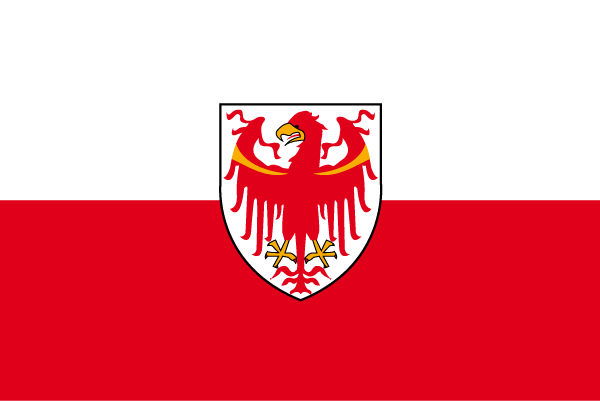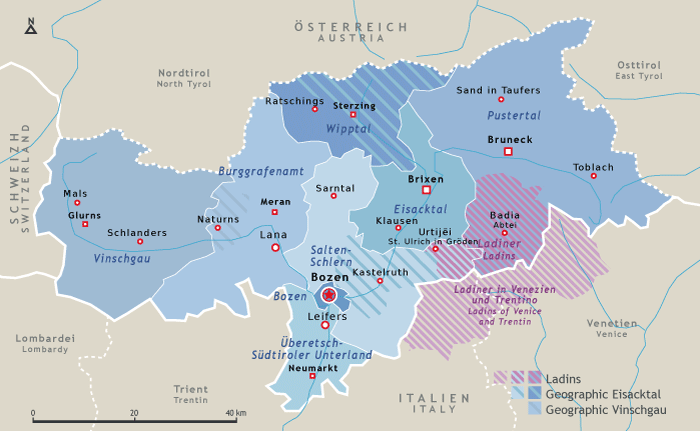South Tyrol, Germanic people of south

South Tyrol or Südtirol is a German-speaking territory in the north of Italy, to which it is reluctantly linked historically. Austrians at heart, the South Tyroleans today benefit from a strong autonomy, permitting them to live their lives free from interference.

Inhabited since the Mesolithic era, there exist traces of human presence on South Tyrolean land. Part of the Roman Empire from 59 AD onwards, the Germanic people succeeded them, in particular Bavarians and Lombards of the 6th–9th centuries. From the 10th century, South Tyrol became a stronghold, a base of the Germanic Roman Empire in the Alps. Ruled by the Habsburgs in the 14th century, it wasn’t annexed to Italy until 1918, after the Treaty of Saint-Germain. The fascist regime led to a strong repression of Tyroleans from 1922. Hitler and Mussolini agreed and “offered” two options to the Tyroleans. Stay and be Italianised or head towards Germany and be stateless.
After the Second World War, an automonous status for South Tyrol was negotiated in Paris (Gruber-De Gasperi Agreement). It did not come into effect immediately. In parallel, Italy organised the arrival of many migrants from southern Italy. This situation of quasi-colonisation frustrated the local populations. From 1957, the Committee for the Liberation of South Tyrol (BAS) organised armed struggles initially directed against public buildings. Thanks to the intervention of Austria before the UN Security Council the question of South Tyrol was finally discussed impartially and conciliation was facilitated. Autonomy is now effective. The Tyrolean political parties dominate the political scene allowing it to benefit from an advantageous status and from co-officially speaking the German language.

Brief history

During the Napoleonic wars, Tyrol was annexed by Bavaria, then allied with France. Andreas Hofer spearheaded a resistance movement to liberate the country. Supported a number of years later by Emperor Franz II of Austria (1809), the Tyrolean rebellion was put into full effect. Defying the Bavarians in Sterzing, Hofer became a charismatic figure of Tyrolean patriotism. There were successive victories and defeats. Napolean crushed the Austrians who took back the advantage. In a few months, Hofer succeeded in defeating the invaders. A price was put on his head. Captured, he was executed in Mantua in February 1810. Having become a martyr in Austria, his remains were transferred to Innsbrück in 1823. The Tyrolean anthem now bears his name in the Austrian Tyrol and unofficially in South Tyrol.

Identity card

| Name | Südtirol | German Alto-Adige (Sudtirolo) | Italian (South Tyrol) |
| Population | 530,000 inhab. (2018) |
| Area | 7,400 km² |
| Languages | Deutsch | German Italiano | Italian (official) |
| Number of native speakers | 314,000 | German (2011) 20,500 | Ladin (2011) |
| State of guardianship | Italy |
| Official status | Autonomous province in Italy |
| Capital | Bozen | German Bolzano | Italian (Bozen/Bolzano) |
| Historic religion | Roman Catholic |
| Flag | Südtiroler Fahne | German (Flag of South Tyrol) |
| Anthem | Andreas-Hoferlied / Südtirollied | German (Song of Andreas-Hofer / Song of South Tyrol) |
| Motto | None |

Timeline

- 6th–9th centuries • Introduction of people of Germanic origins, Bavarians and Lombards.
- 4th century • South Tyrol integrates into the Holy Roman Empire.
- 1363 • South Tyrol integrates into the Habsburg Empire.
- 1805 • Andreas Hofer leads the resistance against the Bavarians allied to the Napoleonic armies. He gives his name to the South Tyrolean anthem.
- 1919 • South Tyrol is annexed by Italy following the Treaty of Saint-Germain.
- 1943 • After the agreement between Hitler and Mussolini, the Nazis seize South Tyrol.
- 1946 • Gruber-De Gasperi Agreement in order to find an agreed solution and a status for South Tyrol.
- 1957 • Armed actions of the Committee for the Liberation of South Tyrol.
- 1972 • Second Statute of Autonomy. South Tyrol benefits from widespread powers.

Geography

South Tyrol is found perched in the Alps. Bordered to the north and east by Austria, a country with which it has strong links, its neighbours are Switzerland to the west and Italy (Lombardy, Trentin and Venice) to the south. The boundary between Austrian Tyrol and South Tyrol, imposed after the First World War was designed on the main peaks of the Alps. The Brenner Tunnel (2,020 m) allows contact between the two parts of historic Tyrol. South Tyrol is divided into eight districts (Bezirksgemeinschaft): Bozen, Burggrafenamt, Eisacktal, Puster, Salten-Schlern, Überetsch-Unterland, Vinschgau, Wipptal. Its capital Bozen is found in the centre of the country. The largest part of the population is found between an altitude of 300 and 1,200 m. The vast Alpine pastures and the high pastures enhance the reputation of this region of Europe.



Politics now

The most representative parties
- Südtiroler Volkspartei (SVP) / South Tyrolean People’s Party (Christian democracy, autonomism)
- Bürger Union für Südtirol (BUfS) / Citizens’ Union for South Tyrol (Right-wing populism)
- Die Freiheitlichen (Right-wing populism)
- Süd-Tiroler Freiheit (STF) / South Tyrolean Freedom (Right-wing populism)

